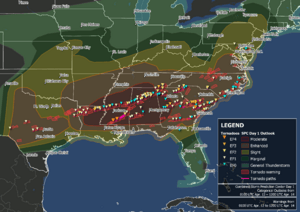2020 Easter tornado outbreak facts for kids

Map of tornado warnings and confirmed tornadoes from the outbreak
|
|
| Type | Tornado outbreak |
|---|---|
| Duration | April 12–13, 2020 |
| Tornadoes confirmed | 43+ |
| Max rating1 | EF4 (preliminary) tornado |
| Highest winds |
|
| Power outages | 1.3 million |
| Total fatalities | 32 fatalities (4 non-tornadic) |
| Areas affected | Southeastern United States |
| 1Most severe tornado damage; see Enhanced Fujita scale | |
The 2020 Easter tornado outbreak was a series of powerful tornadoes that hit the southeastern United States. This happened on Easter Sunday and Monday, April 12–13, 2020. These storms caused a lot of damage and were very dangerous. Sadly, this event caused many people to lose their lives, making it one of the deadliest tornado outbreaks in the U.S. since April 2014.
Contents
What is a Tornado Outbreak?
A tornado outbreak happens when a single weather system creates several tornadoes over a large area. These events can last for hours or even days. They often cause widespread damage. The 2020 Easter outbreak was a big one, with many tornadoes forming across several states.
How Tornadoes Form
Tornadoes are spinning columns of air that connect a thunderstorm to the ground. They form when warm, moist air meets cool, dry air. This creates an unstable atmosphere. Strong winds at different heights can then cause the air to rotate. This rotating air can then drop down to form a tornado.
The Weather Behind This Outbreak
The Easter 2020 outbreak was caused by a strong weather system. This system brought together all the right ingredients for tornadoes. There was a lot of warm, humid air from the Gulf of Mexico. A cold front also moved in, creating a clash of air masses. This led to very strong thunderstorms.
Storm Watches and Warnings
Before and during the outbreak, weather experts issued many warnings. They put out 15 "tornado watches." A tornado watch means conditions are right for tornadoes to form. Two of these were called "Particularly Dangerous Situation" (PDS) watches. A PDS watch means there's a very high chance of strong, long-lasting tornadoes. This helps people prepare and stay safe.
Where the Tornadoes Struck
The tornadoes mainly affected the Southeastern United States. States like Mississippi, Louisiana, Alabama, Georgia, and South Carolina saw the most damage. Some tornadoes also hit parts of North Carolina, Tennessee, Texas, and Maryland. The storms traveled across many miles, leaving a path of destruction.
The Power of the Storms
Many of the tornadoes were very strong. Tornadoes are rated on the Enhanced Fujita (EF) Scale. This scale goes from EF0 (weakest) to EF5 (strongest). The Easter outbreak included tornadoes as strong as EF4. An EF4 tornado has winds between 166 and 200 miles per hour (267–322 km/h). These powerful winds can cause incredible damage. They can even destroy well-built homes.
Damage Caused by the Outbreak
The tornadoes caused widespread damage. Many homes and buildings were destroyed or badly hurt. Trees were snapped or uprooted. Power lines were knocked down, leaving over 1.3 million people without electricity. Roads were blocked by debris. The damage was so severe in some areas that it took a long time to clean up and rebuild.
Images for kids
-
Satellite image of the extratropical cyclone responsible for the outbreak across the Southeastern United States at 21:56 UTC on April 12
-
Severe damage to a grove of trees, including partial debarking, near Livingston, South Carolina, from an EF3 tornado on the morning of April 13.





